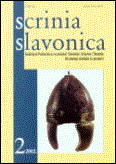USTROJAVANJE SELJAČKE SLOGE U SLAVONIJI, SRIJEMU I BARANJI (1925.-1941.)
THE ORGANISATION OF SELJAČKA SLOGA IN SLAVONIA, SRIJEM AND BARANJA (1925-1941)
Author(s): Suzana LečekSubject(s): History
Published by: Hrvatski institut za povijest
Summary/Abstract: The cultural and educational organisation Seljačka sloga was a subsidiary association of the HSS (Croatian Peasant Party) and consequently shared the good and the bad with it. In the relatively short periods in which political repression slackened, Seljačka sloga managed to cram in an extraordinary amount of work in all the areas of Croatia (1925 – 1929, 1935 – 1941). Slavonia did not lag behind, and if indeed the expansion of the branch network was a little late during the 1920s, the difference in the density of distribution and in the activities of the Slavonian branches and those of the central area of north west Croatia from which the movement spread could no longer be felt after 1935. Up to 1929, 52 branches were founded in Slavonia, but almost half of this number was set up in the last months of the work of the organisation, partly out of protest against the assassination of HSS delegates in the Parliament in 1928. In this period the area of Western Slavonia was much more thickly covered. During the 1930s, this difference disappeared, and Eastern Slavonia was equally involved in the work of Seljačka sloga. Of the 209 branches working in the area in this period, as many as 61 were founded or revived in the first winter (1935 – 1936), and the level of activity was stepped up again when Banovina Hrvatska was created (winter 1939 – 1940). According to the idea of the leadership of Seljačka sloga, primarily of the president, Rudolf Herceg, all the work in the branches was meant to be taken on by the peasants themselves, and in the 1930s this was largely achieved. The local educated class was fairly well in evidence up to 1929, and later is hardly mentioned. An advance was made in the attraction of women to the branches, in which Slavonia, in spite of the occasional complaint, was much better off than other parts of Croatia. In just a few years of work, Seljačka sloga managed to carry out a great deal of multifarious work: getting rid of illiteracy and encouraging writing among the peasantry, the preservation of national art, costume and songs, the organisation of educational get-togethers in the countryside and reviews and shows (in Zagreb), still going on today, the foundation of a court of good and honest people (actually creating their own legal system), and many economic initiatives (co-operative societies, accident insurance, charity campaigns). There were at least 9,000 members gathered together in the cause in Slavonia, all ready to carry out its broadly based aims. Unfortunately, the war destroyed most of the foundations that Seljačka sloga had built up so devotedly and with so much self-sacrifice.
Journal: Scrinia Slavonica
- Issue Year: 2002
- Issue No: 2
- Page Range: 325-352
- Page Count: 28
- Language: Croatian

